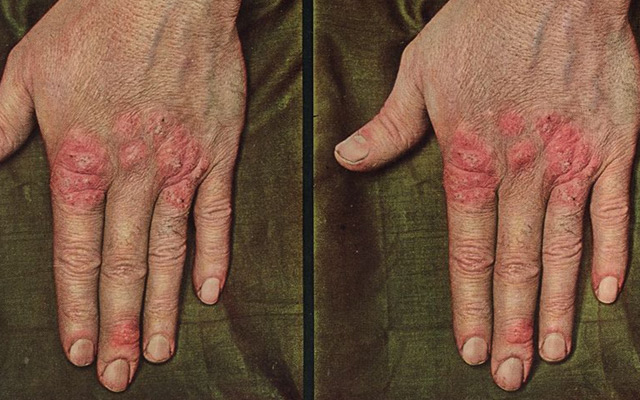Syphilis Tertiaria
- Title
- Syphilis Tertiaria
- Description
- Dermatologic stereoview card. Front of card shows a side view of a female breast and stomach with Syphilis Tertiaria. The reverse of the card describes the dermatologic conditions as well as the diagnosis and treatment. The tubercular syphilid as denoted may appear from one to forty years after the onset of the disease. Individual tubercles are pinhead to hazel-nut sized nodules. Their evolution is like that of an ordinary boil, but without the signs of inflammation. They are firm, elastic, rounded smooth or slightly scaly, brownish red protuberances. Their most peculiar and typical characteristic is a tendency to occur in segmental groups or to coalesce with the formation circinate or serpiginous patches or tracts, and the fusion is usually so intimate that individual tubercles are not longer to be distinguished. There is generally a result of scaring or atrophy of the skin. This form of Syphilis Tertiaria is known as Syphilis tubero-serpiginosa.
- Date
- 1910
- Original Format
- stereographs
- Extent
- Local Identifier
- LL02.49.00.105
- Creator(s)
- Subject(s)
- Spatial
- Location of Original
- Laupus Library History Collections
- Rights
-
This item has been made available for use in research, teaching, and private study. Researchers are responsible for using these materials in accordance with Title 17 of the United States Code and any other applicable statutes. If you are the creator or copyright holder of this item and would like it removed, please contact us at als_digitalcollections@ecu.edu.
http://rightsstatements.org/vocab/InC-EDU/1.0/ - Permalink
- https://digital.lib.ecu.edu/21211
- Preferred Citation
- Cite this item
- This item
-
 Syphilis Tertiaria
Syphilis Tertiaria
- My Collections Login
- Printable Feedback Form
- Found in theme/project
-
 Laupus Health Sciences History Collections
Laupus Health Sciences History Collections
-
 Health and Medicine
Health and Medicine
-
 Stereoscopic Skin Clinic
Stereoscopic Skin Clinic
- Location of Original
- Stereoscopic Skin Clinic Cards from the Laupus Library History Collections
- View all digitized items from the Stereoscopic Skin Clinic Cards
Related Search Results
Public access is provided to these resources to preserve the historical record. The content represents the opinions and actions of their creators and the culture in which they were produced. Therefore, some materials may contain language and imagery that is outdated, offensive and/or harmful. The content does not reflect the opinions, values, or beliefs of ECU Libraries.
Contact Digital Collections
If you know something about this item or would like to request additional information, click here.
Comment on This Item
Complete the fields below to post a public comment about the material featured on this page. The email address you submit will not be displayed and would only be used to contact you with additional comments or questions.


